Summer isn't over yet, and there's still time to observe some of the most beautiful treasures the sky has to offer. The summer Milky Way provides the best view towards the center of our galaxy, and scattered amongst the billions of stars are gigantic clouds of gas and dust. Many of these clouds (called "nebulae" by astronomers) are high-energy regions of stellar birth. Some are actively condensing nebulae in which baby stars are beginning to shine brightly. Reddish regions are warm and often surround a nursery of newborn stars seen as a cluster, and are called Emission Nebulae. Regions that are bluish in color are reflecting the light of nearby stars and are called Reflection Nebulae. This image shows several nebulous regions that are located in the summer Milky Way. At the top is M20, the Trifid Nebula. The larger region in the bottom middle is M8, the Lagoon Nebula. The nebula on the left is a complex of doubly-ionized Hydrogen regions catalogued as Sharpless 2-29, 31, and 32. Amateur telescopes (or even a good pair of binoculars) can easily be used to observe M8 and M20. I took this image in June, 2010 over several nights using a 7" telescope and CCD camera, from my backyard Xanadu Observatory. Total exposure time using 4 different filters was about 14 hours.
Friday, September 9, 2011
Sunday, August 29, 2010
Solar Astronomy
 Xanadu Observatory is now capable of 24-hour astronomy, with the addition of a Lunt LS100THa Solar Telescope. This scope allows direct observation of the nearest star. It's a refractor with a special tuning and filtering system to allow transmission of only a very slight amount of the sun's light. Normally, one would go blind from looking at the sun, but this scope makes it safe.
Xanadu Observatory is now capable of 24-hour astronomy, with the addition of a Lunt LS100THa Solar Telescope. This scope allows direct observation of the nearest star. It's a refractor with a special tuning and filtering system to allow transmission of only a very slight amount of the sun's light. Normally, one would go blind from looking at the sun, but this scope makes it safe.In reality, I probably will not use the solar scope inside the observatory much. I've painted the inside of Xanadu black, which is great for nighttime observing but makes it an oven in the day. I've got some learning to do to get the most out of this scope, and I'm planning to image through it eventually. Even with the drastically reduced amount of light that passes through the filter, imaging the sun will be a much different process than normal astroimaging. The quantity of light reaching the camera will still be far greater, and also the sun exhibits dynamic short-term activity, so one big difference will be taking shorter exposures.
Sunday, May 30, 2010
False Colors, True Wonder
Here's an image of two bright nebulae found in the summer constellation of Cygnus, the Swan. NGC7000 is called "The North American Nebula", and IC 5070 is called "The Pelican Nebula". These bright nebula consist primarily of Hydrogen gas (like most of the rest of the Universe), and in this rendition I've mapped the glow from Hydrogen-alpha emission to the green color channel. I also used filters that gathered light from OIII (doubly-ionized oxygen) and SII (singly-ionized sulfer), and mapped that data to blue and red color channels, respectively. This color mapping strategy is known as "The Hubble Pallet" and results in a false-color image; the nebulae shown above would certainly not appear to be green to the naked eye. In "reality", they would appear to us to be reddish, since H-a is the dominant emission and it comes at a wavelength of about 6563 angstroms, which is in the region of the spectrum that our eyes see as "red". Note that the SII data would also be in the red, so it's impossible to create an RGB image from these filters without mapping something as a false color.
Does this diminish the beauty, the true wonder of observing these amazing interstellar objects? Personally I don't think so. Using the color maps allows visual interpretations of the nebulae that might not otherwise be possible. If I were trying to use the data for some critical science application, the colors probably would be irrelevant anyway. When using the data to create a representation of the wonders of our universe, a representation that may stir the soul in ways that words cannot, I think it's acceptable to take some artistic license and work with false colors.
This is my first image with some new 5 nano-meter bandwidth filters, and clearly I could have improved it by simply rotating the camera slightly. Nevertheless, I hope you find a bit of enjoyment in viewing this image. For more information and a higher-resolution version, visit http://www.xanaduobservatory.com/ngc7000.htm.
Sunday, May 9, 2010
The Bigfoot Nebula
Here's an image of an interesting place in our Universe. This object is a cloud of gas, and there is enough ionized Hydrogen to emit the reddish light that you see here. The light is actually a very specific emission at about 6,562.8 Angstroms, and is known as "Hydrogen-Alpha" or "H-alpha". Although the gas is glowing "hot", it would actually be quite sparse and extremely cold if you were in it. From our vantage point, which is believed to be about 400 parsecs away, (practically next door in astronomical terms!), the cloud takes on a unique shape that reminds me of a footprint from the legendary "Bigfoot" creature of North America. Thus, I call it "The Bigfoot Nebula", but it has a more scientific-sounding official catalog name of Sharpless 2-129.
The bluish coloring in his big toe is a reflection nebula - the probable reason is that the denser gas in that region has condensed and a newborn star is burning brightly enough to reflect some of its blue light against the surrounding gas.
Also visible at the upper right of this image is a smaller nebula, vdB 140, which has both reddish emission as well as bluish reflection components.
For a high-resolution version of this image, as well as image details, click here: http://www.xanaduobservatory.com/Sh2-129.htm
As seems to be normal for some time now, I've been collecting lots of imaging data and getting very little of it completed in the processing stage. The busy phase of my life seems to take over more often than I'd like. But I'm grateful for so many things, as we all should be. Today is Mother's Day, and I continue to grow in my respect for my own Mom, who taught me so much about how precious life is and how important it is to take time to appreciate the amazing beauty that surrounds us. She isn't an astronomer, but I think I owe my fascination with the Universe to her. Thanks Mom!
Friday, March 5, 2010
Backyard Observatory Night at TAAA
This evening's gathering of the Tucson Amateur Astronomy Association was our periodic "Member Observatories" night. It's a popular meeting with various members showcasing their personal observatories. I always learn a few new tricks and it's fascinating to see what others have done to solve the various problems that face small observatory owners. It's also amazing to see how different they are, whether in construction style, size, or price.
We're lucky here in Tucson to have so many amateur astronomers, and with the often-clear skies, building a backyard observatory can be a very worthwhile project.
I gave a short presentation on Xanadu West, my vinyl-shed roll-off-roof observatory.
Tuesday, February 16, 2010
AAPOD for February 17, 2010
It's always a thrill when one of my astro images gets recognition, so when I got an e-mail this evening telling my that my rendition of the Christmas Tree Cluster & Cone Nebula region was selected as the Amateur Astronomy Picture Of the Day (AAPOD), I was very happy!
AAPOD is hosted at the Astronomy.FM website, which is an outstanding source of astronomy information. One of the unique features of this site is their "AFM Radio", which broadcasts various astronomy-themed audio programs over the internet. It's free and there are a lot of topics covered.
I took this image back in October, 2009 using an ST-10XME camera. I later targeted this same region with a wider-field camera. Both versions, along with acquisition details, can be viewed on my Xanadu Observatory website by clicking here.
I suppose that published images feed my ego a bit. It takes an awful lot of work to set up the equipment properly, plan an observing run, acquire the data, and process it to obtain a visually pleasing result, so when an image is published it provides affirmation that someone believes I've done a good job - and who doesn't appreciate an occasional pat on the back? There's no paycheck, so it's a labor of love - that's what makes it Amateur.
AAPOD is hosted at the Astronomy.FM website, which is an outstanding source of astronomy information. One of the unique features of this site is their "AFM Radio", which broadcasts various astronomy-themed audio programs over the internet. It's free and there are a lot of topics covered.
I took this image back in October, 2009 using an ST-10XME camera. I later targeted this same region with a wider-field camera. Both versions, along with acquisition details, can be viewed on my Xanadu Observatory website by clicking here.
I suppose that published images feed my ego a bit. It takes an awful lot of work to set up the equipment properly, plan an observing run, acquire the data, and process it to obtain a visually pleasing result, so when an image is published it provides affirmation that someone believes I've done a good job - and who doesn't appreciate an occasional pat on the back? There's no paycheck, so it's a labor of love - that's what makes it Amateur.
I learned from my mother, who is a wildlife artist, to appreciate the beauty and glory of nature. When I work on an astroimage, I'm hoping to capture just a bit of that, and sharing it with others makes it even more meaningful. Similarly, I love to view astroimages taken by others. One of my first astronomy books was "New Handbook of the Heavens", a worn-covered discard from the Hilton Central School District's library, but a true treasure trove to me. Published in 1941, the photo on page 198 of the "Andromeda Nebula" from Mt. Wilson awakened the dreamer in me that still exists today. (Of course we now know this object as the Andromeda Galaxy, not Nebula, and instead of the 800,000 light-year distance per the book, it's believed to be about 2.5 million light-years away).
(Note - AAPOD is not to be confused with APOD, the Astronomy Picture Of the Day site that often has landscape and professional telescope images).
Sunday, February 14, 2010
Grand Opening of the Chiricahua Astronomy Complex
Last night was the first star party at the Tucson Amateur Astronomy Association's new Chiricahua Astronomy Complex.
We've been eagerly waiting for this night for several years, beginning with a test visit that several of us made on a warm summer's night a few years ago. It's been a long haul - Cochise County has placed many restrictions on the club during the acquisition and development of the property. I won't go into details here (there are enough to fill a small book!), but the County just granted approval for us to actually allow events to occur on the site this past week.
So far we only have basic facilities - parking lot, electricity, bathroom, etc. - but we have the beginnings of a fantastic club observing site. Long range plans include full observatories and pads to set up telescopes.
I was too tired to take all of my imaging gear out, so instead I just brought a visual instrument, my 15" Dobsonian. My buddy Larry drove down with me in my "AZTRNMY" pickup, and we hauled his 18" Dob along as well. The photo above shows our scopes getting ready for work, and there were many other scopes set up all around us. There were 24 people there (I think), and the excitement level was high.
The sky was very clear, and my Sky Quality Meter gave nice dark readings of 21.68 magnitudes per square arcsecond by early evening. The Zodiacal Light was prominent for a while after sunset - this is a faint glow along the ecliptic that results from sunlight reflecting off of dust in space, and is generally only visible from very dark sites. Later in the evening I measured 21.81 on the meter, which is about as dark as I've ever been able to get anywhere. There are some lights along the distant horizon but they really didn't affect the observing.
My friend and imaging mentor Dean brought his ccd equipment and started off his session with a quick one of Messier 34, an open cluster in Perseus. Click here to see his image, which was taken in honor of The Perseus Group, the 4 members who donated the parcel of land to the club.
I spent my time visually observing and socializing with friends. One of the great things about a star party is sharing the night sky and outdoors with wonderful people, and last night was no exception. I viewed numerous objects through a variety of scopes and eyepieces. Mars was a favorite target, with the polar ice cap as well as dark surface markings clearly visible. The Orion Nebula, M42, was another object whose photons graced the surfaces of many mirrors last night. One of the more unusual visual objects that I observed last night was the Horsehead Nebula. Although that is a popular imaging target (in fact I have many hours of unprocessed ccd data on it), it's rare in the eyepiece. I used my H-Beta filter on the 15" and several of us enjoyed the view. There were a lot of other nebulae, galaxies, star clusters, etc. that we viewed, along with plenty of laughter and swapping of stories.
Seeing was very good, with a steady sky making it easy to pick out details in the objects we observed. All in all it was a great night and I can't wait for more to come!
Monday, February 8, 2010
Seeing Red
It's a nice clear night so far in Tucson. I went out to open the roof on the observatory, and could not resist the urge to stop and enjoy the night sky for a little while.
Although most of us think of the stars as a bunch of little white points of light, they can actually be quite colorful for anyone who takes the time to observe them carefully. These winter nights provide an excellent opportunity to view some nice red objects. When I looked East this evening, I was immediately struck by the 3 bright red points of light that stand out in the crowd. The lowest, and brightest, is the Angry Red Planet Mars. A bit higher and to the South is the amazing Red Supergiant Betelgeuse, one of the members of the dramatic constellation of mighty Orion. Farther up lies deep red Aldebaran, the leader of the v-shaped Hyades cluster and an important component of the sharp horns of Taurus the Bull.
Looking deeper into space, one finds red over and over. Most nebulae glow red as they emit photons created from the ionization of Hydrogen, which makes up the vast majority of the known universe. Interstellar dust and gas creates a reddening effect on many of the objects we observe.
This image is a wide-field rendition of the Christmas Tree Cluster and Cone Nebula region. The dominant red color shows relatively dense regions of hydrogen gas, commony called HII regions. Click here for a better view of the image and more information about how the image was obtained.
Right now my telescope and camera are obtaining data for another HII region, known as IC 2177 and commonly called the Seagull Nebula. I suspect the humidity will force me to close the observatory before midnight, since we have had considerable rain in the past few weeks, but for now my scope and I are enjoying our amazing universe.
Although most of us think of the stars as a bunch of little white points of light, they can actually be quite colorful for anyone who takes the time to observe them carefully. These winter nights provide an excellent opportunity to view some nice red objects. When I looked East this evening, I was immediately struck by the 3 bright red points of light that stand out in the crowd. The lowest, and brightest, is the Angry Red Planet Mars. A bit higher and to the South is the amazing Red Supergiant Betelgeuse, one of the members of the dramatic constellation of mighty Orion. Farther up lies deep red Aldebaran, the leader of the v-shaped Hyades cluster and an important component of the sharp horns of Taurus the Bull.
Looking deeper into space, one finds red over and over. Most nebulae glow red as they emit photons created from the ionization of Hydrogen, which makes up the vast majority of the known universe. Interstellar dust and gas creates a reddening effect on many of the objects we observe.
This image is a wide-field rendition of the Christmas Tree Cluster and Cone Nebula region. The dominant red color shows relatively dense regions of hydrogen gas, commony called HII regions. Click here for a better view of the image and more information about how the image was obtained.
Right now my telescope and camera are obtaining data for another HII region, known as IC 2177 and commonly called the Seagull Nebula. I suspect the humidity will force me to close the observatory before midnight, since we have had considerable rain in the past few weeks, but for now my scope and I are enjoying our amazing universe.
Sunday, February 7, 2010
Imported Blogs Below From Astronomyblogs.com
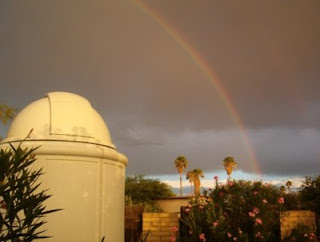
I've just completed moving most of my old blogs over to this site.
I previously used Astronomyblogs.com, but that site's owner has told me that he may discontinue it. I am grateful to astronomyblogs.com for getting me started in blogging and hosting my ramblings for the past few years.
The import process was not automated - it took a lot of "cut-and-paste". Many of the images came over as very low resolution bitmaps instead of their original jpeg format, and none of the embedded links crossed over.
But at least I have an archive of the old blog here now.
There has been an awful lot of astronomy stuff going on in my life since my last astronomyblogs post back in June of 2009. I won't bother trying to catch it all up, but there is new equipment, the roll-off roof observatory is fully operational, I attended the 2009 Advanced Imaging Conference, and I'm still heavily involved in the local astronomy club.
I plan to continue this blog to track my pursuit of amateur astronomy.
06/21/2009 C-Row Star-B-Que
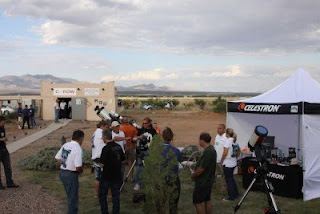
For the past two nights, I've been enjoying the Huachuca Astronomy Club's C-Row Star-B-Q. This event was held at the Repogazer (RGO) Observatory.
The theme of C-Row is Celestron; the main observing field was filled with various Celestron telescopes and accessories. Celestron will be 50 years old next year, and there was plenty of vintage gear on the field. My contribution to the C-Row was my little white tube C-5+.
Celestron's corporate headquarters sent out various executives and sales personnel, and they set up a nice booth with demos, including the new CGE+ and some prototypes of new telescopes with flat optics.
Friday night was basically clouded out, so I left early and headed home for a good night of sleep. Last night, however, was very clear and a beautiful Milky Way set the stage for a great night of observing. In addition to some visual work through varoius friends' scopes, I played a little bit with the AstroTrac and digital camera.
There was a big raffle giveaway last night - in fact, every one of the 150 attendees won a prize! My big winning was a year's subscription to Astronomy Magazine. This was definitely a great event, and I'm looking forward to doing it again next year.
05/21/2009 SAS Symposium
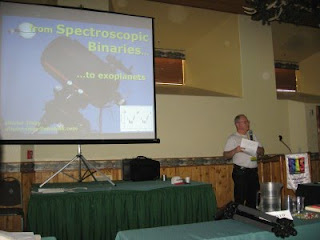
I'm here in California for the Society for Astronomical Sciences Symposium on Telescope Science. Today was a day full of seminars on amateur astronomy from a science perspective. Most of the talks related to photometry and spectroscopy. This year they combined the SAS meeting with the AAVSO (American Association of Variable Star Observers) meeting, so it's quite large, with several hundred attendees.
This picture shows my friend Olivier Thizy giving his spectroscopy talk. Olivier runs Shelyak Instruments and we had a great time playing with the LHIRES III Spectrograph up here a couple of years ago. This time he brought along his new high-end Echelle spectrograph, which I am drooling over!
There are several Tucson folks here, including my friend Steve and Darryl, Mark, and others. Also a bunch of the "usual" star party folks and vendors, like James, Don, Kevin, etc. Overall I'm having a great time.
On Friday we'll head a few miles down the road to the RTMC Astronomy Expo. Hopefully I'll see a bunch of good friends there as well.
04/21/2009 Ready for More
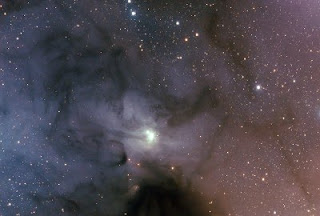
The sun's going down and a new night of fun is starting here at TSP. I didn't get nearly enough sleep today but that's o.k., I'm ready for more!
Here's an image of IC 4603, the nebulous region around the interesting star Rho Ophiuchius (how do you pronounce that, anyway?) I took this in the early morning hours the past couple of nights. The numerous dark tendrils weaving their way around this area are really fascinating.
Click here to see a larger version of this image.
Meanwhile it's time for me to attend to the scopes...
04/21/2009 The Milky Way Rising Over TSP

It's 6 a.m. and I'm just wrapping up an excellent observing night at the Texas Star Party.
I took the picture above with my Canon DSLR about 3 hours ago, it is a single 10-minute shot with the camera aimed towards the center of our Milky Way galaxy, tracking on an AstroTrac and tripod.
We had a lot of success, including some good CCD imaging and completion of some of the TSP Observing Lists.
Time for some rest now!
04/20/2009 The Stars at Night, Are Big and Bright, Deep in the Heart of Texas!

Here I am for another exciting week at the Texas Star Party, one of my favorite astronomy escapes. After arriving yesterday and setting up all the gear, I was pretty exhausted, but still managed to stay up most of the night.
This picture shows the two telescopes that I brought along - my Epsilon 180 for imaging, and my Obsession 15" for visual. The sky last night was very dark and seeing was excellent, so I had a great time with both scopes.
This afternoon I spent some time in the amateur radio shack, and made about 100 QSO's for the W5TSP special event station.
Tonight's going to be clear again and I'm looking forward to some more fun. There are a bunch of Arizona folks here from both TAAA and HAC, including Larry (who I drove out with), Dean, Bob, and Glenn. Plus I know a bunch of others from previous star parties, etc., so it's a great social time as well.
04/04/2009 Asteroid Workshop Day Two
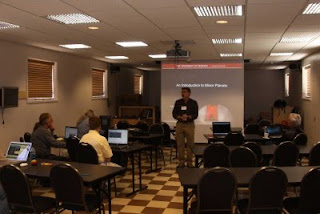
Had a great day yesterday learning about asteroids and NEO's. We had some of the CSS astronomers give talks, and also spent a good part of the day working with Astrometrica software. Astrometrica can be used to identify possible asteroids and NEO's in image frames.
We also learned how to check data with the Minor Planet Center, and how to submit observation reports. Hopefully I will obtain some data sometime soon, and with my first submission I'll be eligible to request an MPC Observatory Code for Xanadu Observatory.
The weather last night wasn't good so we never did open the dome. I drove down the mountain around midnight, which meant missing the final few hours of the workshop this morning. Other obligations today made it necessary, but I think I got some very valuable information out of the workshop. Plus, it's always very enjoyable to spend time in an astronomy environment with professional observatories all around!
04/03/2009 Asteroids and Near Earth Objects Workshop
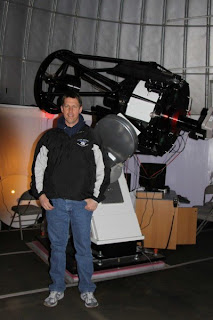
Last night was the first night of the Mount Lemmon Sky Center's Asteroids and Near Earth Objects (NEO's) Workshop.
I decided to take a short break from an extremely busy tax season to try to learn a few new things. I have not done a lot of asteroid work in the past so thought it might be fun.
We started the workshop with an hour-long tour of the University of Arizona's Mirror Lab, which builds many of the world's largest telescope mirrors. They were currently in the process of grinding mirrors for the GMT (Giant Magellan Telescope), and the LSST (Large Synoptic Survey Telescope).
After driving up the mountain, we spent some time observing and imaging the Sun through a new Lunt Solar Systems 100mm Hydrogen-alpha scope. There were several small prominences and a very faint sunspot.
Later we took some data on various fields using this telescope, a 24" Ritchey-Crieten made by RC Optical Systems. We'll be processing this data today and learning how to identify asteroids in the field, as well as determine if there are any new ones. That's not likely, since the Catalina Sky Survey (CSS) already covers much of the sky and presently makes about 70% of the discoveries of NEO's. While we were obtaining data, we took a walk to the dome next door, which houses the 60" telescope used by CSS. One of their astronomers was busy taking data, and he showed us their system which is really fascinating. They routinely observe as many as 8,000 asteroids per night, and it is not unusual for them to discover new NEO's, main-belt asteroids, and even comets.
The weather started to deteriorate before midnight, with high winds and humidity, so we didn't observe all night (probably a good thing since I needed some sleep badly).
Today we will learn how to identify objects in the fields, and determine whether there are any new ones to report. The speakers today will be Adam Block and a few astronomers from the CSS. We're in a very nice "Learning Center".
The picture above was taken last night as we prepared to start our imaging run. As you can see even early in the evening it was quite cold - there is even snow up here!
I also was interviewed earlier this week by a writer for the Arizona Daily Wildcat, which is the U of A's daily newspaper. They published the article, which can be viewed here, but I was disappointed because they misquoted me and emphasized the threat of an asteroid hit, which really wasn't the main focus of my comments during the interview. My main reason for being here is quite simply to satisfy my thirst for knowledge - it's interesting stuff. I'm really not planning to discover "The Big One".
03/07/2009 TAAA AstroImaging Night
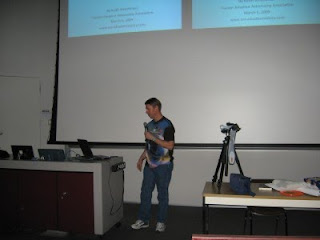
Last night was the (approximately) annual TAAA AstroImaging night. Members of the astroimaging special interest group get a chance to share their techniques and photos with the rest of the club. It's always a lot of fun and we see some amazing images.
Steve gave the astronomy essentials portion of the meeting with a talk on basic astroimaging. After the break, we split up presentation duties among some of the members of the SIG.
I was one of about 8 presenters, and just showed some of my more recently processed images. Here's a pciture of me doing my gig.
The room was packed, I didn't count but I'd estimate about 250 people came. After the talks, a bunch of folks went out for some food and we talked astronomy for another hour or two. It was a late night but a lot of fun!
02/21/2009 High Speed Comet
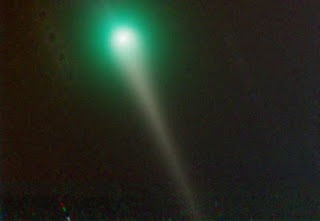
Lately the astronomy world's been buzzing over Comet C/2007 N3, also known as Comet Lulin. It's grown rather bright, with naked-eye visibility. It also sports a rather greenish coma and has a long tail.
Comets are usually short-lived phenomena for observers - although some of them return on a periodic basis, most of them will only be visible once in an amateur astronomer's lifetime. They also can surprise us with erratic behaviour, so it's always fun to watch them.
I took this image two nights ago. It consists of 96 subframes (24 in each red, green, blue, and luminance), only 30 seconds each. Although the total exposure time was 48 minutes, with the added time for focusing, exposure downloads, guide star acquisition, etc., the total elapsed time between the first and last image was almost 2 1/2 hours. Since the comet is moving across the sky quite rapidly, I decided to make a little movie showing the motion as well. Click Here to see this image in higher resolution, and to view the comet movie.
I'm not sure I'll get another chance to image this one, as clouds have taken over the Tucson skies and my workload remains heavy. But I'm very happy to have had a chance to snap a brief picture of this celestial friend as he sped by!
02/09/2009 Staying Busy
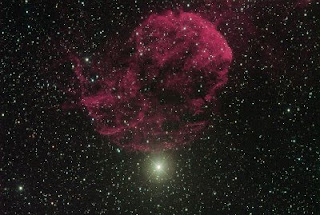
Here we go again, a whole month has passed with no blogs. I guess I'm just too busy with stuff. Lots of work to do as usual at this time of year, plus I've been spending a lot of time with the radio hobby. And of course there are family obligations, Board meetings, this, that, and pretty soon I find it's tough to get on and blog, even though I enjoy it.
I have been doing quite a bit of imaging, but unfortunately the processing has not kept up with the data acquisition so I now have about 30 objects to process!
Here's one that I took back in December and January, it is the Jellyfish Nebula (IC443) in HaRGB format. For a larger version click here.
While processing this image, I "discovered" an asteroid passing right through the nebula. Turns out it was actually discovered in 1887 and carries the designation 270 Anahita. But it was still fun for me to find it trekking through my chosen object. Click here for a short animation of my "discovery".
01/06/2009 Star Light, Star Bright
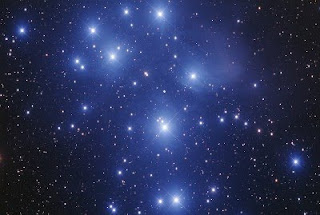
Clear crisp winter nights can be some of the best times for astronomical observing. There is something about the chill in the air that makes the sky more appealing. In reality the cold winter nights are not always the best for seeing conditions, but naked eye views of the sky seem to bring an almost mystical perspective when the night air has that quiet chill. At my house, there are a couple of owls that like to make their "who-who"'s which makes it even more magical.
One of the objects that faithfully shines brightly in the winter sky is the Pleiades open star cluster, catalogued by Messier as M45. The Pleiades is a nice little grouping that many non-astronomers will notice (as long as their eyesight is reasonably good), and sometimes they will even mistake it for the Little Dipper since it does have a dipper-like appearance.
This image was taken back in December on several clear cold nights. Total exposure time for each color filter was 2 hours (24x5 min each) plus another 48 min of Luminance. The blue reflections in the nebulosity surrounding the cluster are easily visible in an eyepiece, but the nebulosity itself is believed to be an unrelated interstellar dust cloud that the cluster just happens to be passing through. Imagine what the sky would look like if you lived on a planet in this area!
Click Here for a larger, higher resolution version of this image.
Subscribe to:
Posts (Atom)








